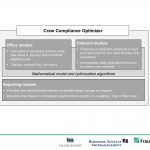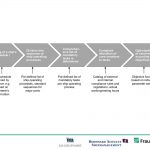With the enforcement of the Maritime Labour Convention 2006, there has been a tremendous increase in the need for information with regard to compliance issues.
In an effort to ensure appropriate manning and operation of ships, the partners Fraunhofer CML, E.R. Schiffahrt and Bernhard Schulte[ds_preview] Shipmanagement have developed the Crew Compliance Optimizer, which encompasses all relevant aspects of compliance and safe operation issues.
Starting point
Two questions are important:
– How many seafarers with which qualifications are necessary to safely operate a specific ship on a particular port schedule?
– How can I ensure an optimal working schedule on board with a given crew size at any time?
These questions may appear quite simple at first glance, but it was the root cause behind the cooperation initiated by E.R. Schiffahrt with Fraunhofer CML. The answers are closely linked to onboard working conditions, which have changed considerably in recent years. Shorter port stays and higher administrative burdens make it challenging for crews to reconcile their effective working hours with the stipulated rest regulations. Furthermore, work schedules on board are often subject to numerous sources of compliance irregularity, in particular when compelled by operational overriding conditions or commercial requirements.Shipping companies face several risks arising from non-compliance incidents relating to hours of work and rest. Apart from crew fatigue and associated safety aspects, possible detentions can also have a detrimental effect on shipping companies´ reputations and expose them to financial risks. This is especially true in light of the fact that the MLC 2006 [Maritime Labour Convention 2006. Compendium of maritime labour instruments (2008). Geneva: International Labour Office.] will be enforced in most major countries by the end of 2014 and great importance is attached to Concentrated Inspection Campaigns already announced by the Port State Control Committee. Furthermore, as of the year 2015 an enhancement to the ISM-Code [International safety management code (ISM code) and guidelines on the implementation of the ISM code (2010). 2010 ed., 3rd. ed. London: International Maritime Organization.] forces companies to »ensure that each ship is (…) appropriately manned in order to encompass all aspects of maintaining safe operations on board.« Some classification societies have already announced an inquiry into internal company methodologies of determining crew size and consistency by means of annual audits.
Staffing ships to conform with compliance regulations, assigning flexible daily work assignments for every position and rank on the ship as well as ensuring efficient recovery after non-compliance incidents creates a complex planning problem for the the vessel’s captain and the office. From the point of view of E.R. Schiffahrt and Bernhard Schulte Shipmanagement, existing systems currently available on the market do not provide the necessary decision support to overcome today´s challenges. Prior to the development of the Crew Compliance Optimizer, decisions were based mainly on the planner at the office’s or the captain’s experience.
Aim of the new Crew Compliance Optimizer
The Crew Compliance Optimizer (CCO) takes into account a multifaceted legal framework, mainly based on the STCW Convention of IMO [International Maritime Organization (2011): STCW including 2010 Manila amendments. STCW Convention and STCW Code. 2011. ed. London: International Maritime Organization.] and Convention 180 as issued by ILO/MLC 2006 [International Labour Organization (ILO): C180 – Seafarers’ Hours of Work and the Manning of Ships Convention, 1996 (No. 180).] as well as numerous customer and company internal requirements. Its three main goals are as follows:
Onshore computation of necessary manpower demands per ship depending on a specific port schedule and remaining work times of crew members, e.g. for maintenance purposes. The goal is to provide decision support for the office by providing crew work schedules that fulfil compliance requirements
Onboard decision support in the form of a compliance optimized relief plan, showing work and rest periods per position for specific periods. The automatically generated work schedule will consider actual work and rest hour accounts of every crew member in combination with real-time voyage situations on a half-hourly basis. One focus lies on tracking and short term recovery from non-compliance incidents.
Consolidation and preparation of relevant data for external inspections (e.g. time sheets) and company internal and external controlling purposes (e.g. compliance reports per ship or fleet).
As a result, three integrated modules were designed within the Crew Compliance Optimizer: office, onboard, and reporting modules as depicted in Figure 1.
Decision support for crewing and quality departments
The Office module enables decision makers to calculate the minimum demand of seafarers for safe and compliant ship operations. Therefore, the planner just has to enter the planned port schedule as well as his preferred adjustment, e.g., specific watch-keeping patterns or compliance constraints. The CCO tool will divide the port schedule into a sequence of ship operating processes such as, for example, transit, pilot takeover, and bunkering, and combine it with a pre-defined list of mandatory tasks per position. The scheduling algorithms subsequently allocate all tasks to qualified crew members, based on set compliance regulations and company internal requirements. Finally, the scheduling solution is optimized by algorithms according to a given objective function (Fig. 2).
The results are shown in heads or full time equivalent (FTE). In certain situations, the latter figure is more relevant to the planner, e. g., when the FTE figure in a certain time span indicates that new working arrangements with one more or one less seaman are advisable, or when it is deemed advantageous to shift tasks to different ranks. This forward-looking approach allows for individual and situational staffing, e. g. by using riding crews.
Furthermore, the planner is able to analyze to within half an hour the calculated work status of every position, the compliance status of positions along the schedule, and the available free time slots for additional work tasks such as maintenance.
Onboard planning support
The Onboard module of the CCO is adapted to the specific planning needs of the master. The main output of the CCO is a schedule of working and resting times for each seafarer onboard the ship. Just as in the Office module, users are able to easily alter the planned sequence of ship operating processes, as modifications to the actual voyage schedule occur on a daily or, in extreme cases, an hourly basis. The aim is to facilitate the generation of an adjusted working schedule in case of voyage changes at short notice. An extended bunkering or a change in the expected pilot takeover, for example, may lead to an imbalance in the working and resting hour arrangements for certain positions. The daily updates on the working and resting hours of every crew member constitute an important input, which is processed within the scheduling and optimization algorithm before the new work schedule is published.
Furthermore, recently developed key figures, like the ship compliance index as well as the personnel compliance index, enable a quick evaluation of the specific onboard situation as well as allowing for comparisons across the fleet.
Reduction of administrative burdens
The Reporting module is designed to simplify the administrative management of working and resting hours on board and on shore. Several process steps, like registering the hours of work and rest and generating inspection documents, will – in part – be documented automatically and will replace the manual completion of prescribed forms.
An integral part of the reporting module is the synchronization of viral information with the responsible office department. The module supports the transmission of all time sheets for controlling purposes or the report of possible cases of exceeding acceptable working times with their corresponding comments.
Conclusion and outlook
In light of the enforcement of the MLC 2006 regulations and the intensified inspections by port state controls, shipping companies and crew managers will in future undoubtedly focus their attention on the issue of compliance with working and resting hours.
Numerous parties will benefit from utilizing the CCO. For the first time, shipping companies are in a position to give analytically derived answers to the fundamental questions posed at the beginning of this article. Based on mathematical methods, shipping companies are now able to define the required crew composition and manning level for a specific ship type and size resulting from current and future operating areas. In addition, the increased transparency regarding workloads has the advantage of achieving time budgets for maintenance purposes or anticipated personnel costs.
The ships command is now equipped with an urgently needed tool, which offers assistance by providing work schedules on demand and taking into account the given rules and regulations. Additionally, many administrative tasks and reporting obligations will be rendered redundant by the automatic exchange of necessary information between ship and shore.
The prototype of the CCO as described above will be implemented by E.R. Schiffahrt and Bernhard Schulte Shipmanagement this year and will be followed by an intensive testing period under real-life conditions. The implementation of the CCO tool will affect existing planning and execution processes at the office and on board. Here, further adjustments are to be expected in order to ensure the best possible approach. Among others, one main issue on board will be to further simplify the documentation of each crew member›s working and resting hours. Suitable approaches could be the utilization of automatic monitoring and recording concepts, like attendance terminals or the use of tablet computers. Subsequent development stages of the CCO-Tool could also include enhanced scheduling of maintenance tasks or the modification to adapt to future legal and internal requirements. The CCO prototype will be part of the Fraunhofer CML exhibition stand at the SMM.
Ole John, Marc Gunther Schmidt, Andre Delau

























